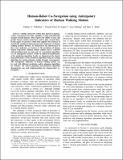| dc.contributor.author | Unhelkar, Vaibhav Vasant | |
| dc.contributor.author | Perez D'Arpino, Claudia | |
| dc.contributor.author | Shah, Julie A | |
| dc.contributor.author | Stirling, Leia A. | |
| dc.date.accessioned | 2017-01-13T20:45:52Z | |
| dc.date.available | 2017-01-13T20:45:52Z | |
| dc.date.issued | 2015-05 | |
| dc.identifier.isbn | 978-1-4799-6923-4 | |
| dc.identifier.uri | http://hdl.handle.net/1721.1/106484 | |
| dc.description.abstract | Mobile, interactive robots that operate in human-centric environments need the capability to safely and efficiently navigate around humans. This requires the ability to sense and predict human motion trajectories and to plan around them. In this paper, we present a study that supports the existence of statistically significant biomechanical turn indicators of human walking motions. Further, we demonstrate the effectiveness of these turn indicators as features in the prediction of human motion trajectories. Human motion capture data is collected with predefined goals to train and test a prediction algorithm. Use of anticipatory features results in improved performance of the prediction algorithm. Lastly, we demonstrate the closed-loop performance of the prediction algorithm using an existing algorithm for motion planning within dynamic environments. The anticipatory indicators of human walking motion can be used with different prediction and/or planning algorithms for robotics; the chosen planning and prediction algorithm demonstrates one such implementation for human-robot co-navigation. | en_US |
| dc.language.iso | en_US | |
| dc.publisher | Institute of Electrical and Electronics Engineers (IEEE) | en_US |
| dc.relation.isversionof | http://dx.doi.org/10.1109/ICRA.2015.7140067 | en_US |
| dc.rights | Creative Commons Attribution-Noncommercial-Share Alike | en_US |
| dc.rights.uri | http://creativecommons.org/licenses/by-nc-sa/4.0/ | en_US |
| dc.source | MIT web domain | en_US |
| dc.title | Human-robot co-navigation using anticipatory indicators of human walking motion | en_US |
| dc.type | Article | en_US |
| dc.identifier.citation | Unhelkar, Vaibhav V. et al. “Human-Robot Co-Navigation Using Anticipatory Indicators of Human Walking Motion.” IEEE, 2015. 6183–6190. | en_US |
| dc.contributor.department | Massachusetts Institute of Technology. Computer Science and Artificial Intelligence Laboratory | en_US |
| dc.contributor.department | Massachusetts Institute of Technology. Department of Aeronautics and Astronautics | en_US |
| dc.contributor.department | Massachusetts Institute of Technology. Department of Electrical Engineering and Computer Science | en_US |
| dc.contributor.department | Massachusetts Institute of Technology. | en_US |
| dc.contributor.mitauthor | Unhelkar, Vaibhav Vasant | |
| dc.contributor.mitauthor | Perez D'Arpino, Claudia | |
| dc.contributor.mitauthor | Shah, Julie A | |
| dc.contributor.mitauthor | Stirling, Leia A. | |
| dc.relation.journal | IEEE International Conference on Robotics and Automation, 2015. ICRA '15. | en_US |
| dc.eprint.version | Author's final manuscript | en_US |
| dc.type.uri | http://purl.org/eprint/type/ConferencePaper | en_US |
| eprint.status | http://purl.org/eprint/status/NonPeerReviewed | en_US |
| dspace.orderedauthors | Unhelkar, Vaibhav V.; Perez-D'Arpino, Claudia; Stirling, Leia; Shah, Julie A. | en_US |
| dspace.embargo.terms | N | en_US |
| dc.identifier.orcid | https://orcid.org/0000-0002-4530-189X | |
| dc.identifier.orcid | https://orcid.org/0000-0002-1999-7395 | |
| dc.identifier.orcid | https://orcid.org/0000-0003-1338-8107 | |
| dc.identifier.orcid | https://orcid.org/0000-0002-0119-1617 | |
| mit.license | OPEN_ACCESS_POLICY | en_US |
